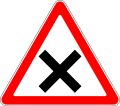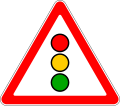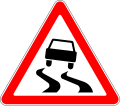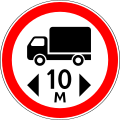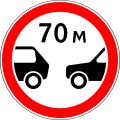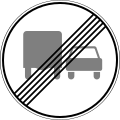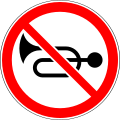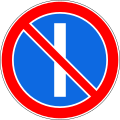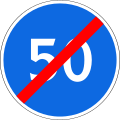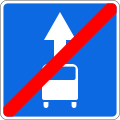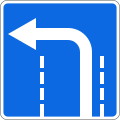History
The world's first road signs were approved at an international conference of motorists in 1909; among the participants were the Russian Empire. There were four road signs of that time and all of them were round: "uneven surface", "crossroads", "bends", and "railway crossing". New road signs and signals were officially adopted already in the USSR on 1 December 1927. In 1933, the number of road signs in the USSR was increased to 23 and they received the current shapes and colours, and for the first time they were divided into three categories: "warning", "prohibition" and "indicative". The following changes and additions regarding road signs were adopted on 1 January 1961, after the USSR joined the Geneva Convention on Road Traffic in 1959. The number of road signs has increased to 36. All signs received a yellow background. In 1968, the Convention on Road Traffic and Road Signs and Signals was created in Vienna. On 8 November 1968, the Soviet Union signed the Vienna Convention on Road Signs and Signals, and on 7 June 1974 ratified it. [7] [8] New rules of the road, as well as road signs adopted by this convention, entered into force in the USSR in 1973. Subsequently, changes and additions to the rules of the road, road signs and signals were made in 1975, 1976, 1979, 1980, 1984 and 1987. [9]
Currently, the most common signs are made on a metal substrate covered with a reflective film. Signs that are illuminated around the perimeter or along the contour of the image of the sign, made using miniature incandescent lamps or LEDs, have become slightly widespread.
On 1 January 2006, the modern standard GOST R 52290-2004 for road signs was introduced in Russia, completely replacing the Soviet standard GOST 10807-78. [6] New road signs were introduced in the GOST R 52290-2004 standard:
- Three new warning signs:
- "Speed bump";
- "Dangerous roadside";
- "Congestion".
- A new prohibitory sign "Control" prohibiting passage without stopping at checkpoints is used instead of a stop sign.
- Images of mandatory signs "Turn right" and "Turn left" modified by replacing straight arrows used during the Soviet era with 90-degree ones.
- A new category, special regulations signs, with new road signs:
- "Number of lanes";
- "Restricted parking zone";
- "End of restricted parking zone";
- "Regulated parking zone";
- "End of regulated parking zone";
- "Maximum speed limit zone";
- "End of maximum speed limited zone";
- "Pedestrian zone";
- "End of the pedestrian zone".
- A new sign indicating general speed limits in Russia introduced.
- New service road signs, "reception area of a radio station transmitting traffic information" and "radio communication area with emergency services" were introduced in connection with the development of mobile radio communications in Russia.
- New additional signs indicating various obstacles on the road (refuge islands, traffic islands, etc.).
In June 2018, in connection with the preparations for the 2018 FIFA World Cup in Russia, a new prohibition road sign, "no buses allowed", was introduced. This sign was used as a temporary sign from 1 June to 17 July 2018 during the 2018 FIFA World Cup and after the end of the World Cup, the sign was retired. [10] [11] However, from 1 March 2023, this sign was reintroduced, on a permanent basis, [12] due to changes in the rules of the road in Russia that came into force on that date. [13]
In February 2019, the traffic police supported proposals for the introduction of reduced road signs, the idea was initiated by the Moscow government. They are planned to be installed throughout Russia after a successful experiment. The allowable size of signs will be reduced to 40 cm (16 inches) in diameter, and in some cases to 35 cm (14 inches), which is almost half the current standard of 60 cm (24 inches). [14]
On 1 March 2023, a new prohibition road sign, "no personal mobility devices", was introduced. [15] It prohibits personal mobility devices such as electric scooters, electric skateboards, hoverboards, or segways.
Similar systems
Similar road signs are used in most countries that formed after the collapse of the Soviet Union in 1991. Initially, the GOST 10807-78 standard was adopted in the Soviet Union in 1980, but after its collapse, the same standard continued to operate in many post-Soviet countries until some of these countries adopted their own standard, in particular, in Russia, the GOST R 52290-2004 standard was adopted, in Ukraine DSTU 4100:2021, in Belarus STB 1140-2013, in Kazakhstan ST RK 1412-2017, and in Uzbekistan O'zDst 3283:2017. [17] Road signs in Armenia and Kyrgyzstan are entirely based on the GOST R 52290-2004 and GOST R 52289-2004 Russian standards. [18] [19] Inscriptions on road signs vary depending on the country's official language.
In Estonia and Latvia, road signs are outwardly different from the Russian ones. In Lithuania, road signs still bear a resemblance to those used in the Soviet Union, despite the fact that Lithuania restored its independence in 1990 and that the country joined the European Union in 2004. This is due to the fact that the Baltic states were occupied and later annexed by the Soviet Union in 1940 during the World War II.












